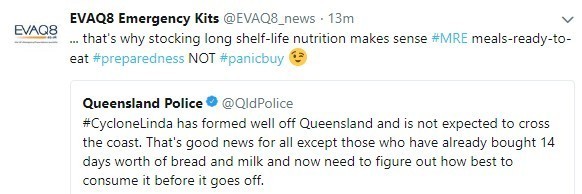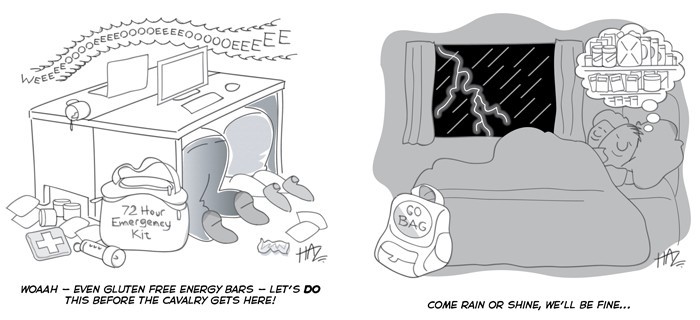Have you seen some of the lovely snow and ice pictures floating around on social media since yesterday? This blog about Cold Weather Preparedness is the exact opposite from my earlier post on Heatwave – beyond Heat Health Watch to Personal Preparedness back in June. Since we are pretty firmly on a path where we need to Prepare for a world that’s more than 2°C warmer which translates into more frequent and severe weather events, personal preparedness really does make a lot of sense. You can take pro-active steps to be better prepared and stay well and healthy also with regards to being #WinterReady. So….
What is personal preparedness for a cold wave?
First, it’s about being informed which then means you can get better prepared. Let’s break this down and a good example here is this post from the Northamptonshire Emergency Planning Team. Take a closer look at the graphic:
@MetOffice issued Level 3 #coldweather alerts across #Northamptonshire. Dress warmly, keep active and clear icy pavements if possible. Throughout #winter, have plenty of warm food and drink to keep you warm & check on vulnerable people #weatheraware #prepared #winterready pic.twitter.com/aPCGzN42bS
— NorthantsEmergencies (@NorthantsEPTeam) December 8, 2017
The UK’s MetOffice issues Cold Weather Action alerts as part of ‘Cold Weather Health Watch’. This system operates in England from the 1 November to 31 March every year and runs in association with Public Health England. Currently there is a level three AMBER warning in place which for the authorities means that social and healthcare services must execute specific actions with regards to high-risk population groups such as the very young, the elderly or those with certain chronic health conditions. What exactly happens on the government side, you can find out on the Cold Weather Plan for England. Importantly, you can take personal steps to be better prepared. Cold weather can mean snow and ice which, if you’re out may look like this
❄️ ❄️ The cold Arctic air is back with us. Here’s where you can expect to see snow in the UK this weekend. #uksnow ❄️❄️ https://t.co/VhnVT7GdcC — Liam Dutton (@liamdutton) December 8, 2017
Naturally, it makes a lot of sense to prepare yourself and your vehicle properly before setting out. Stay updated on the weather and road conditions and allow for plenty of time. This blog, naturally, recommends proper winter driving preparedness, for example:
Personal #Preparedness matters | https://t.co/KIqCuQazkD#RoadSafety #HealthandSafety #WinterReady #car #travel #weekend #driving #snow #ice #RTC #crash #delays #weatheraware #prepared pic.twitter.com/G9l6GHlDNk
— EVAQ8 Emergency Kits (@EVAQ8_news)
@MetOffice issued Level 3 #coldweather alerts across #Northamptonshire. Dress warmly, keep active and clear icy pavements if possible. Throughout #winter, have plenty of warm food and drink to keep you warm & check on vulnerable people #weatheraware #prepared #winterready pic.twitter.com/aPCGzN42bS — NorthantsEmergencies (@NorthantsEPTeam) December 8, 2017
… and listen to Dave, he has excellent advice for the enthusiastic:
Yes it’s snowing. Yes it looks pretty. Yes you may also own a 4×4.
Just remember, you’re NOT invincible. You’ll still need to drive to conditions.#Snow #RoadSafety pic.twitter.com/SK1H3Aplty
— Dave Harford (@dharford79) December 8, 2017
In addition, preparing properly for a Cold Wave also concerns your home; for example see our info page on severe winter preparedness. Keep in mind that freezing temperatures, snow and ice have other consequences, such as power cuts which may also impact your home food safety . Therefore, you may want to consider some basic shelter-in-place measures and stocking the right emergency food which you can prepare and enjoy even when utilities become disrupted.
Keeping warm is key during a cold weather alert. There are easy and simple steps you can take to stay safe at home and when going out:
- keep your main rooms heated, use extra blankets
- take extra care with electrical items and be #FireSafety aware
- dress in layers and keep active
- take extra care when out and about to avoid accidents
- stay #weatheraware, have the right kit and supplies
Finally, a super
TOP TIP for Cold Weather preparedness
… and you will laugh for it’s a very small thing. Carry an emergency foil blanket in your backpack or handbag. It’s cheap, hardly takes up space nor adds weight and is a potential life saver. And that, by the way, applies for business too which should always stock emergency blankets as part of their business preparedness.
Cold weather alert level 3: make sure your #preparedness plan includes emergency foil blankets https://t.co/J5QLz6hUky#business #healthandsafety #Cumbria #Northumberland #Yorkshire #Lancashire #Cheshire #Norfolk #Suffolk #Essex #Kent #Sussex #Somerset #Dorset #Cornwall #Devon pic.twitter.com/WIoqbPCWk0
— EVAQ8 Emergency Kits (@EVAQ8_news) December 8, 2017
And so I leave you with a couple of lovely winter images and wish you a warm and prepared rest of the week and a cosy and safe weekend #StaySafe #bePrepared.
Monika
Quite a few people have woken up to #snow in parts of the UK this morning. Share your images using #loveukweather.
Here are a few that have been sent in already ☃️
Stay #WeatherAware and keep up to date with our warnings here https://t.co/b3lIwa2UeZ pic.twitter.com/cU39oBewS0
— Met Office (@metoffice) December 8, 2017
If you like this post, please share it to help raise awareness for Emergency and Disaster Preparedness.
Tweet thank you for sharing!
For more EVAQ8 blog simply use the right hand navigation. For emergency kits and practical resources use the top navigation. For FREE resources head over to our Preparedness Hub and find out why we use humour. If you like this post, please share it to help raise awareness for Emergency and Disaster Preparedness. Thank you!
Find EVAQ8 on social media, like and follow us!
It pays to be #winterready and better prepared. Avoid being stranded! Check out our info page What goes into a Winter Car Emergency Kit .
Hundreds of drivers have been stranded in Scotland due to heavy snow fall.
Kenneth was stuck in his car all night, with his fiancee and dog. pic.twitter.com/CmMrQfnDga— BBC Breakfast (@BBCBreakfast) January 17, 2018



 And I’m being entirely practical, not sarcastic (and truthful) like the
And I’m being entirely practical, not sarcastic (and truthful) like the 







 For more on practical Emergency and Disaster Preparedness head over to our FREE resources at the
For more on practical Emergency and Disaster Preparedness head over to our FREE resources at the 

